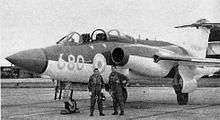700 Naval Air Squadron
| 700 Naval Air Squadron | |
|---|---|
|
700 NAS badge | |
| Active |
1940-1944 1944-1949 1955-1961 1998-2008 2009-2014 2014- |
| Country | United Kingdom |
| Branch | Royal Navy |
| Role | Operational Evaluation Unit |
| Part of | Fleet Air Arm |
| Garrison/HQ | RNAS Yeovilton and RNAS Culrose (700X Squadron) |
| Motto(s) |
Experientia docet (Latin: "Experience teaches") |
700 Naval Air Squadron (700 NAS) is a squadron of aircraft in the Royal Navy’s Fleet Air Arm.
History
700 NAS was originally formed in January 1940 at RNAS Hatston (HMS Sparrowhawk) in Orkney in a plan to centralise the operations of the 700 series "Catapult" flights attached to catapult units and to act as a pool and Headquarters for all catapult aircraft embarked on battleships and cruisers - chiefly the Supermarine Walrus flying boat and Fairey Seafox floatplane.
On 21 June 1940, a Walrus (P5666) of 700 Squadron on the cruiser HMS Manchester found the German battleship Scharnhorst but Manchester did not engage.
Trailing German capital ships in the lead up to the Battle of the Denmark Strait, Walrus L2184 of 700 NAS from HMS Norfolk was damaged by shellfire from Prinz Eugen in the Denmark Strait on 23 May 1941 while still on its catapult.
The final successful attack on an enemy submarine by a Walrus was on 11 July 1942, when Walrus W2709 of 700 (Levant) NAS sank the Italian submarine Ondina, along with the South African surface vessels Protea and trawler Southern Maid, east of Cyprus.
There were at least 5 confirmed enemy submarines sunk or damaged by Walruses during the Second World War, including the Vichy French submarine Poncelet which was bombed by Walrus L2268 of 700 NAS from HMS Devonshire and attacked by HMS Milford on 7 November 1940 off the Cameroons. The submarine was damaged and forced to surrender, and later scuttled off the Gulf of Guinea. The crew of Petty Officer P H Parsons, Sub Lt A D Corkhill and N A Evans were all awarded gallantry medals.
700 NAS was disbanded in March 1944, pilots transferring into 771 Naval Air Squadron, but it was reformed as a Test Pilot School in October 1944.
700 NAS re-emerged in August 1955 as a Fleet Requirements unit and from 1957 was based out of RNAS Lee-on-Solent to introduce the Westland Whirlwind HAS.7.
Intensive Flying Trials Units (IFTU)
- 700H NAS
- 1955-57, RNAS Lee-on-Solent, Westland Whirlwind HAS.7
- 700X NAS
- 1957-58, Supermarine Scimitar F.1
- 700Y NAS
- 1958-59, RNAS Yeovilton, de Havilland DH.110 Sea Vixen FAW.1
- 700X NAS
- 1959-61, RNAS Yeovilton, Saro P.531
- 700H NAS
- 1960-61, HMS Vengeance, Fairey Gannet and Hawker Sea Hawk deck and launch trials
- 700H NAS
- 1960-?, Westland Wessex HAS.1
- 700Z NAS
- 1961-63, RNAS Lossiemouth, Blackburn Buccaneer S.1
- 700V NAS
- 1963-64, Westland Wessex HU.5
- 700W NAS
- 1963-64, Westland Wasp HAS.1
- 700B NAS
- 1965-?, RNAS Lossiemouth, Blackburn Buccaneer S.2
- 700H NAS
- 1967-?, Westland Wessex HAS.3
- 700P NAS
- 1968-69, McDonnell Douglas F-4K Phantom II FG.1
- 700S NAS
- 1969-70, Westland Sea King HAS.1
- 700L NAS
- 1976-77, RNAS Yeovilton, Westland Lynx HAS.2
- 700A NAS
- 1979-80, RNAS Yeovilton, BAe Sea Harrier FRS.1
- 700L NAS
- 1990-92, RNAS Yeovilton, Westland Lynx HAS.2, (Lynx CTS Trials)
- 700M NAS
- 1998-2008, RNAS Culdrose, AgustaWestland Merlin HM.1
- 700W NAS
- 2009-2014, RNAS Yeovilton, AgustaWestland Wildcat HMA.2
- 700X NAS
- 2014-, RNAS Culdrose, Boeing Insitu ScanEagle
The Squadron carried on trials of de Havilland Sea Vixens on HMS Victorious and HMS Centaur during 1958 and from October 1959 formed at Yeovilton with the Saunders Roe P.531 to investigate what would be needed to introduce a whole new form of helicopter operation to the Fleet – which led to the Westland Wasp.
In October 1960 flight tests of landing and take-offs from HMS Vengeance with 27 launchings of the turboprop Fairey Gannet and 34 with the Hawker Sea Hawk.

700 NAS disbanded again at RNAS Yeovilton in July 1961. However, a number of Intensive Flying Trials Units were subsequently formed under the "700 NAS" title, to prepare for new aircraft types coming into service. These operated as independent units, each being identified by a suffix letter after the squadron number (e.g. "700B").
Several of these IFTUs were formed for the introduction of the Westland Wessex, Blackburn Buccaneer, McDonnell Douglas F-4 Phantom II, Westland Sea King, Westland Lynx and BAe Sea Harrier into the Fleet Air Arm.
More recently, the squadron was re-commissioned at RNAS Culdrose in December 1998 as 700M Squadron, with a primary role of testing and evaluating the AgustaWestland Merlin HM.1 helicopter. 700M disbanded on 31 March 2008, transferring its aircraft and personnel to 824 Naval Air Squadron and also forming a new flight, 824 OEU. The squadron reformed again as 700W NAS in May 2009 at Yeovilton as the Lynx Wildcat Fielding Squadron. 700W expects to receive up to five Wildcats from January 2013 for operational evaluation and conversion training.[1] The squadron was disbanded in July 2014 when it was merged with 702 NAS to form 825 Naval Air Squadron, the first operational Wildcat unit.[2] It was subsequently reformed as 700X NAS to undertake RPAS trials, and to act as a parent unit for the various ship-based flights operating the Insitu Scan Eagle UAV.[3]
Aircraft operated
- AgustaWestland Merlin
- Westland Lynx (introduction to service)
- Supermarine Walrus
- Westland Whirlwind (tests)
- De Havilland Sea Vixen
- Fairey Gannet (tests)
- Hawker Sea Hawk (tests)
- Saunders-Roe P.531 (tests) (only 6 built)
- Westland Wasp (introduction to service)
- Westland Sea King (introduction to service)
References
- ↑ The Fleet Air Arm's Newest Squadron 700W Lynx Wildcat Commissions At RNAS Yeovilton
- ↑ http://www.royalnavy.mod.uk/news-and-latest-activity/news/2014/july/31/140731-700w
- ↑ "X-men take to the Cornish skies". Royal Navy. 25 November 2014. Retrieved 25 November 2014.
